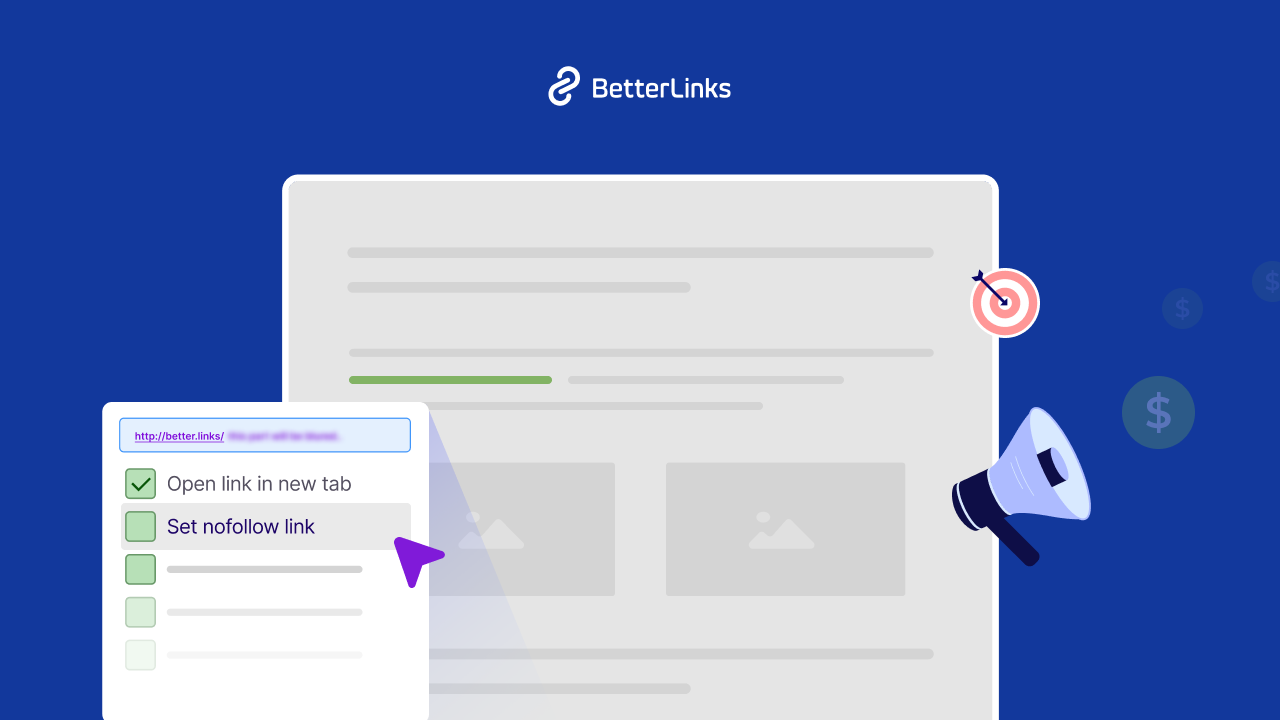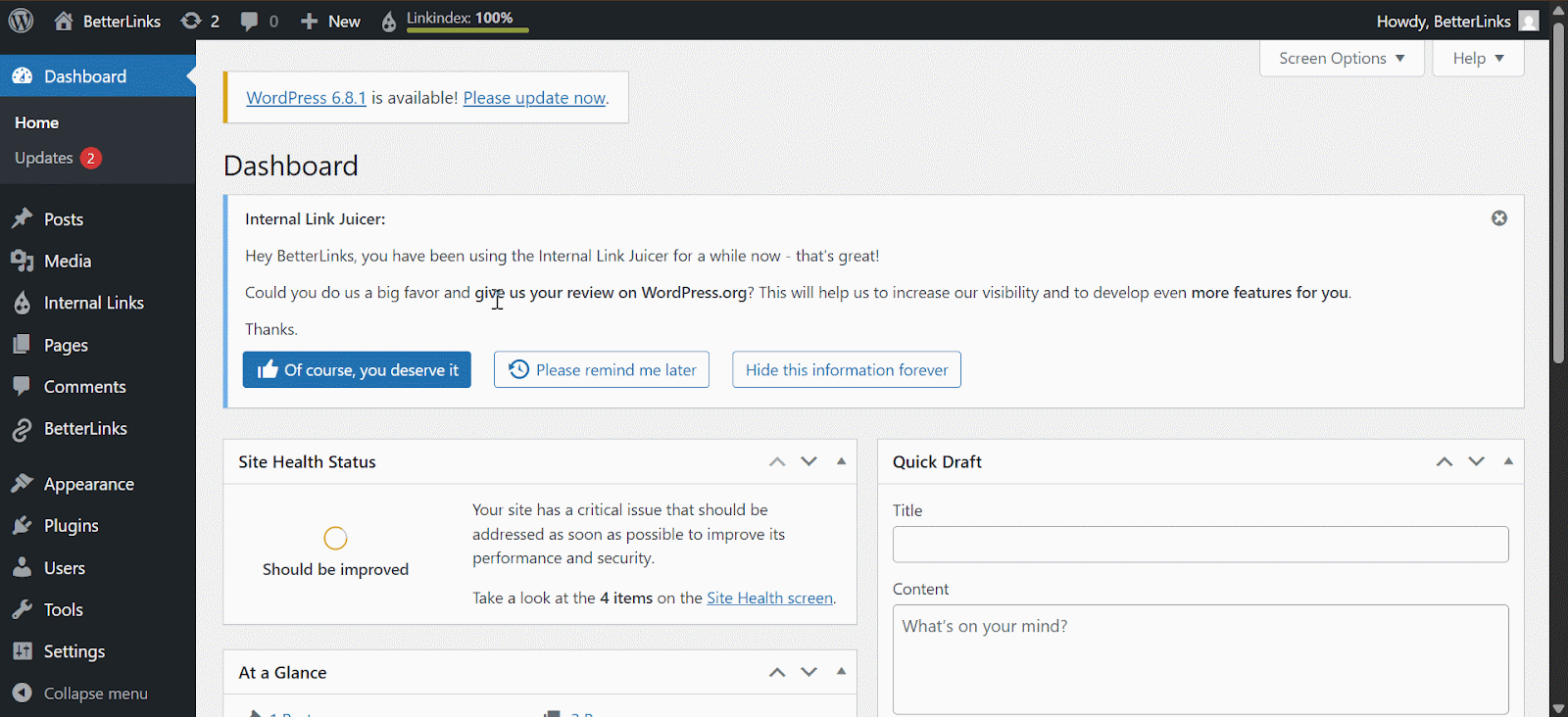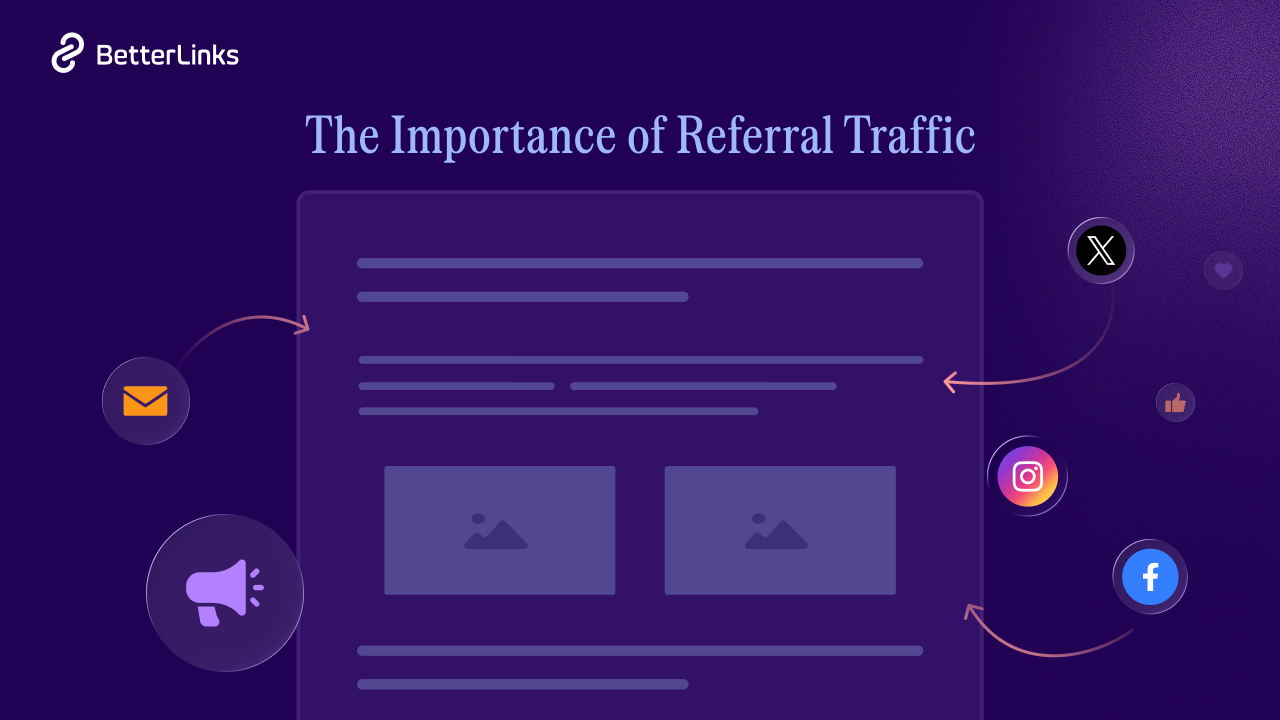Despite the constant changes in Google’s algorithm, affiliate marketers need to remember one thing: improper link management can negatively affect their SEO. In most cases, dofollow links are the default, and this can be risky for affiliate links. A large number of dofollow affiliate links can lead to your site being flagged for unnatural linking, which can harm your rankings. What is the fix? Make sure your affiliate links have the “nofollow” attribute.

This guide explains what nofollow links are, how to use nofollow links for affiliate marketing, and how BetterLinks can automate the process to save you time and protect your rankings.
What Is the Difference Between Dofollow And Nofollow Links?
Nofollow and dofollow links are both beneficial in a well-rounded link-building strategy, but there is a major difference between these two. The ability to know when to use each one helps you maintain SEO strength while maintaining control over which links are most influential.
What Is a Dofollow Link?
In search engine terms, a dofollow link (also called a “follow”) signals to search engines that the linked page should be taken into account when ranking search results. The SEO value of a dofollow link on another site can assist your ranking in search results by passing on its “link juice”.
Some situations, however, do not allow you to share this SEO advantage. That is when you need to use nofollow links.
What Is a Nofollow Link?
Nofollow links include a special tag [rel=”nofollow”] which instructs search engines NOT to pass SEO value to the linked page. To put it another way:
Links to a page usually help it rank better. However, if a link has a ‘nofollow’ tag, it blocks the link’s ;juice’ and will not improve the SEO of the linked page.
The nofollow link will not affect search engine rankings – search engines ignore nofollow links in their ranking algorithms. Using this method, you can link freely without affecting your search engine rankings.
Despite a nofollow link, Google may still crawl the page – a nofollow link does not mean the search engine will ignore the page. However, the link itself will not contribute to Google’s ranking even if it is visited and indexed by Google.

When you use nofollow links, you have greater control over how external content interacts with your site. The use of these links is especially beneficial for affiliate marketing, sponsored content, and user-generated content because they ensure links do not unintentionally affect rankings while still bringing traffic to the site.
Want Better Rankings? Know When to Use Nofollow Links
There is no need to add a nofollow attribute to every link, but when links are associated with monetization, sponsorships, or come from sources you do not control, it is worthwhile. Below are a few examples when it is a good idea to add nofollow to your links:
Affiliate Links – Those links that earn you commissions as part of a partnership or referral program. Because these recommendations are paid in some way, search engines recognize them differently from recommendations that are not paid. In simple words, the use of nofollow links for affiliate marketing is essential.
Sponsored Links & Paid Placements – Links that appear in advertisements, sponsorships, or promotions. Adding nofollow separates sponsored posts from organic links, whether they belong to a blog, a banner, or a partnership.
Links in Comments & Forums – It is common for user-generated content to contain links from other websites. The nofollow tag prevents your site’s links from being unintentionally connected to low-quality or spammy material since you can not control what others post.
If you use nofollow links in such situations, you can protect your site’s reputation from external content that could harm your rankings. If you want to know how to use nofollow links for affiliate marketing, dive deeper because we will show you how BetterLinks can help you do that.
How to Add a Nofollow Link Attribute to Your Affiliate Links Using BetterLinks?
The process of manually adding a nofollow tag to each affiliate link might not seem tedious at first, but after a while, you will find it adds a lot of unnecessary steps. Especially in WordPress, where you have to either edit HTML or adjust settings for each link individually if you publish content on a regular basis.
BetterLinks simplifies this process of using nofollow links for affiliate marketing. You do not need to manually update every link, since you can automate it altogether, so your links remain compliant.
1. The Nofollow Tag: How to Add It to Your Affiliate Links
In BetterLinks, when creating an affiliate link by clicking on ‘Add New Link’, you will get the link options. From there, simply check the ‘No Follow’ box to apply the tag before saving or publishing your link:

2. How to Automatically Add a Nofollow Tag to All Affiliate Links
The easiest way to make all your affiliate links nofollow is to set them up once and forget about them. Go to BetterLinks → Settings → General, then navigate to the ‘Link Options.‘ Here, you will find a similar ‘No Follow‘ check box. Once you are checked, click on ‘Save Settings.‘
If you enable this option, each new link you create in BetterLinks will automatically have the nofollow attribute applied.

The Benefits of Nofollow Tags for Affiliate Links
It is great to monetize your content with affiliate links, but they can negatively impact your website’s SEO if they are not managed properly. When you add the nofollow attribute, you ensure that it serves its purpose – helping you earn without negatively affecting your website’s search engine rankings. Here are some reasons why it is worth considering:
Follow Search Engine Guidelines
Affiliate links must be marked by search engines, such as Google, so readers know they are sponsored or part of a monetization plan.
Affiliate links that use nofollow are clearly labeled as affiliate links, making it clear that they are not organic links. Maintaining this transparency helps you avoid potential penalties and remain compliant with search guidelines.
Keep Your Site’s Authority Intact
Search engines recognize dofollow links as trustworthy, relevant resources by passing ranking value to the pages that they link to. Even though affiliate links are genuine endorsements, they are also paid partnerships, so their impact on SEO should not be significant.
When you use nofollow, you tell search engines that even though you support the product, the link should not carry ranking value. Doing this helps you keep your SEO authority focused on your own content rather than spreading it across many affiliates.
Maintain Transparency And Trust
Neither readers nor search engines expect content that has been monetized to be dishonest. As part of its affiliate disclosure requirements, the FTC also requires clear disclosures.
In addition to helping reinforce transparency, nofollow links help separate editorial content from promotional links. Having links to products you promote shows your readers that you work with businesses that you trust. Having clear recommendations will increase engagement, return visits, and conversions with your audience.
In order to protect your SEO, maintain your site’s credibility, and follow industry best practices, using nofollow for affiliate links is a simple yet essential step.
When Affiliate Links Do Not Use Nofollow, What Happens?
Using the nofollow attribute incorrectly can lead to SEO penalties and a loss of credibility, among other things. The stakes are as follows:

You May Receive a Google Penalty
Google can flag your site for manipulative link building if your site has too many dofollow affiliate links. Consequently, this could lead to:
- A manual action penalty can result in your ranking dropping or even your page being removed from the search results.
- Ranking difficulties persist even after removing the links due to a weak SEO reputation.
- The process of fixing a Google penalty involves reviewing links, cleaning them manually, and requesting a reconsideration.
Your Site Loses Its SEO Value
You lose some of the SEO power of your site when you use dofollow affiliate links. As time goes on, this can result in:
- Increase the difficulty of ranking in competitive search results with your content.
- Decrease organic traffic and authority over time.
When you use nofollow, you keep your ranking power within your website, ensuring that your pages remain competitive in search engine results.
You May Lose the Trust of Your Audience
Transparency is key to affiliate marketing’s success. You may experience the following results if your affiliate links are not properly disclosed or appear to be unfairly influencing SEO rankings:
- Your content will feel overly promotional, damaging its credibility.
- The FTC requires clear disclosures for paid links as part of its guidelines.
Nofollow affiliate links safeguard your site’s reputation while maintaining compliance with SEO and legal requirements.
Your revenue strategy should be supported by affiliate links, not diminished by poor SEO. Maintaining authority, protecting rankings, and staying compliant with search engine guidelines are made easier by adding the nofollow link attribute.
Nofollow Links for Affiliate Marketing: Common Mistakes to Avoid
Nofollow links can confuse or harm your SEO if you do not avoid a few common pitfalls. To avoid these mistakes, follow these steps:
Affiliate Links without Nofollow
The purpose of affiliate links is to monetize, not to improve search engine rankings. By leaving them dofollow, you may misdirect your site’s link juice, sending it to external pages rather than keeping it focused on your content. As a result, your site’s authority may deteriorate and the effectiveness of your internal linking strategy may decrease.
✅ Fix – Make sure affiliate links are always nofollowed – manually or automatically using a tool like BetterLinks – to stay compliant.
Using Nofollow Too Much on Internal Links
Nofollow is only intended for outbound links, not for links within your own website. When your internal links have nofollow attributes, search engines will not crawl or rank your content correctly.
✅ Fix – To prevent Google from not understanding your site structure and passing SEO value between your pages, keep internal links dofollow. Do not follow affiliate links, sponsored content, or external links that are untrusted.
Nofollow Is a Panacea for All SEO Issues
In spite of the fact that nofollow prevents search engines from crawling or indexing a linked page, it does not prevent them from passing ranking value there as well. There are some instances where Google may still consider nofollow links for ranking calculations, even if they are not followed.
✅ Fix: Use the [noindex] tag in place of (or together with) nofollow if you want a page to be completely excluded from being indexed.
If you avoid these mistakes, using nofollow effectively can protect your site’s SEO without unintentionally hurting your rankings.
Let BetterLinks Handle Your Nofollow Link Strategy
Your affiliate strategy will work better if you have nofollow links on your site. Nofollow is a small keyword attribute that may seem insignificant, but overlooking it can lead to big headaches, such as a loss of search engine rankings, audience trust, or even FTC compliance issues.
Then, how do you update each link manually? You would be better off spending that time elsewhere!
With BetterLinks, you will never miss a link or make a mistake. Using this tool, you won’t have to second-guess technical details, so you can focus on building trust, driving conversions, and earning more.
Have you found this blog useful? If you want to read more tips and tricks, you can subscribe to our blog and join our Facebook Community.






